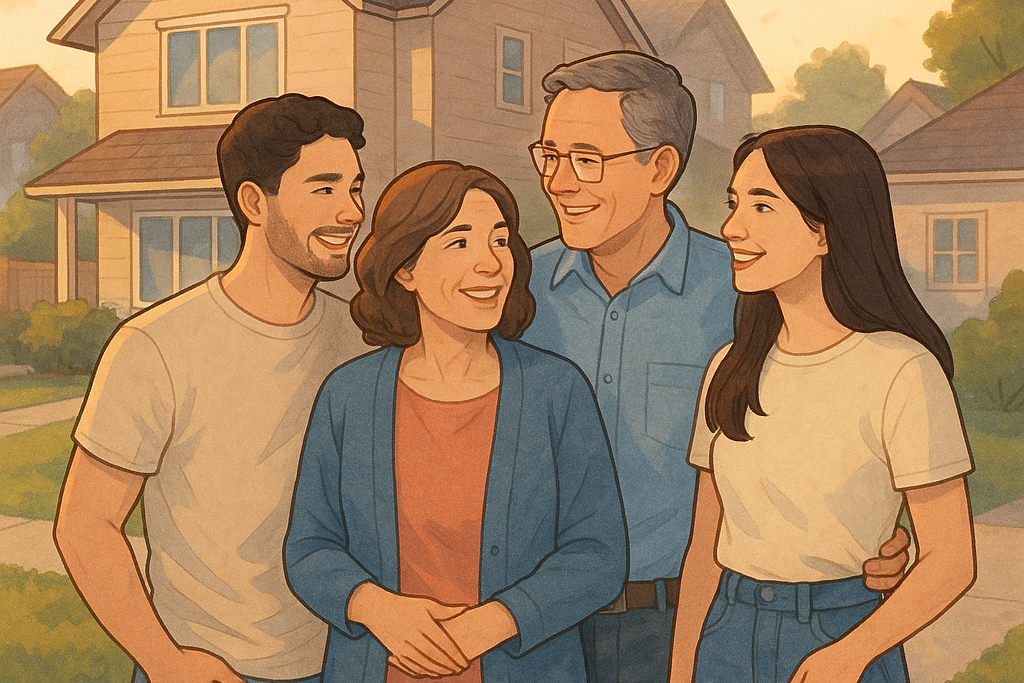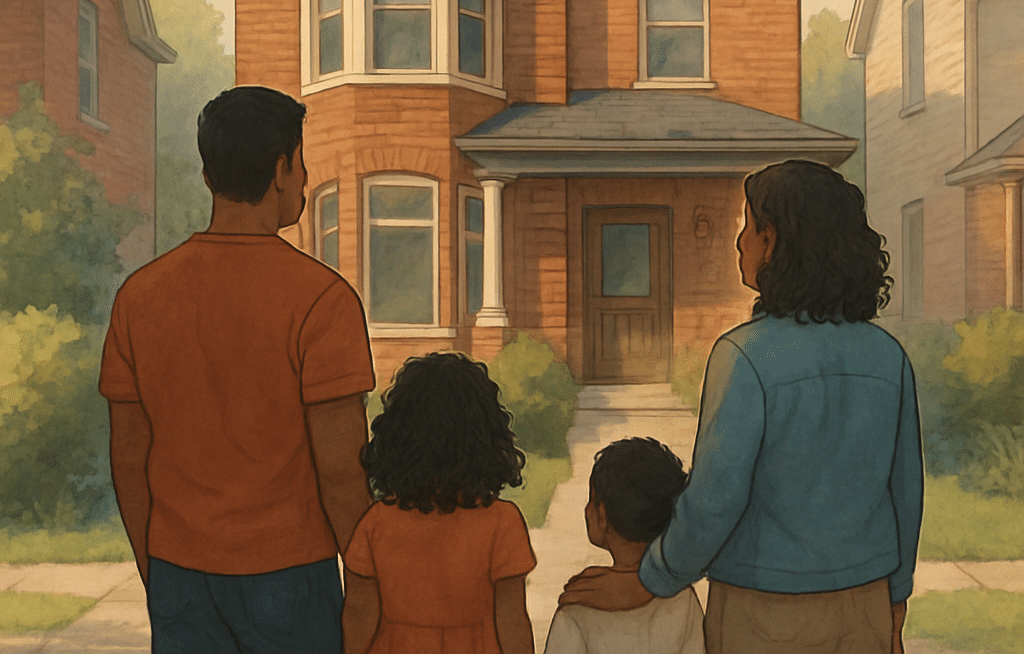For many parents across the Greater Toronto Area, the idea of “empty nest” living has been replaced by something new: the multi-generational home. As housing costs continue to climb and lifestyles evolve, more adult children are staying at home longer – pushing parents to upsize with adult children.
If that sounds familiar, you’re not alone. Across Canada, the number of young adults living with their parents has reached record highs, and the trend shows no sign of slowing down. For many families, this shift has led to a surprising opportunity: to upsizing with adult children in mind.
It’s not just about finding a larger house – it’s about creating a space that fosters independence, connection, and comfort for everyone under one roof.
Why More Families Are Choosing to Upsize Together
Rising housing prices in the GTA have made it difficult for younger generations to afford homes on their own, even with steady careers. Many adult children are choosing to stay with parents longer while they save for a down payment or navigate early adulthood.
This isn’t just a financial decision – it’s a lifestyle choice that reflects modern family values. Parents and adult children alike are realizing the benefits of shared living: emotional support, shared costs, built-in help with daily life, and the ability to stay connected while maintaining privacy.
The trend toward shared homeownership isn’t limited to parents and children either – more families are exploring creative living arrangements like co-upsizing with a sibling, combining resources to create multigenerational spaces that work for everyone.
For parents looking to upsize with adult children can also be a forward-thinking move. It allows them to design a home that accommodates today’s needs – like space for adult children – while preparing for tomorrow’s possibilities, such as aging in place or hosting grandchildren.
The challenge is finding the right balance: how do you create a home that feels shared but not crowded, together but not tangled when you upsize with adult children? The answer lies in smart design and intentional planning.
Planning to Upsize: Thinking Beyond Bedrooms
When planning to upsize with adult children, square footage alone doesn’t solve everything. It’s about how the space works, not just how big it is.
The first step is to identify what kind of independence your family needs. Does your adult child work from home, go to school, or have a partner who visits often? Do you share meals together regularly, or prefer separate routines? Understanding these daily rhythms helps shape the type of layout that will truly support everyone.
Open conversations are essential. Parents may envision cozy family dinners, while adult children may crave privacy or a sense of ownership over part of the home. Designing for both expectations is key – and the layout can make all the difference.
Smart Layouts for Shared Living
1. Separate Suites for Privacy
One of the most effective ways to maintain harmony when you upsize with adult children is to create distinct zones for each generation. Finished basements, converted attics, or above-garage suites can function as semi-independent living areas.
A self-contained suite with its own bathroom, kitchenette, and private entrance gives adult children autonomy while keeping them close. For many GTA families, this is also a strategic investment – homes with secondary suites often increase in value and can later be used as income-generating rental units.
If full separation isn’t possible, even simple design choices can help: positioning bedrooms on opposite sides of the home, adding soundproofing, or installing pocket doors for flexible division between shared and private areas.

2. Dual-Purpose Common Spaces
While privacy is important, connection still matters. A move to upsize with adult children is also about creating comfortable areas to gather – shared spaces that feel open, inviting, and functional for everyone.
Think beyond the traditional living room. Family zones that blend work, entertainment, and dining keep everyone engaged without crowding. A spacious kitchen with a large island can become the hub of daily life, while a second lounge or media area gives everyone their own retreat.
Outdoor living space is another hidden gem for multigenerational families. Backyards, decks, or garden patios offer neutral ground where everyone can socialize without invading personal space. A well-designed outdoor area can make a home feel twice its size.
3. Flexible Floor Plans for Changing Needs
The beauty of co-living with adult children is that it’s rarely permanent – and the right home should adapt as family dynamics evolve.
A flexible floor plan allows rooms to change purpose over time. What begins as an adult child’s bedroom can later transform into a guest suite, home office, or hobby room. Likewise, a large basement might serve as a gym today and an apartment later.
Open-concept designs paired with movable partitions or modular furniture make it easy to redefine space as needed. Families upsizing now should think five to ten years ahead: How might the space serve you later, when adult children move out or start families of their own?
4. Thoughtful Design for Independence and Accessibility
As families grow together under one roof, design details matter more than ever. Noise insulation, lighting, and traffic flow all play roles in maintaining harmony.
Adult children who work from home may need quiet zones, while parents might prefer bright, open areas for relaxation or entertaining. Separate entrances, private bathrooms, and mini kitchenettes give older children the freedom to come and go without disturbing household rhythms.
And for parents thinking long-term, it’s smart to consider accessibility now – wider hallways, main-floor bedrooms, and barrier-free bathrooms can make the home comfortable for years to come.

Location Still Matters – Even When Everyone’s Under One Roof
While upsizing focuses on space, location is equally important. Families often find that moving just a few neighbourhoods away can dramatically change the experience of multigenerational living.
If your adult children work downtown or attend university, proximity to transit is key. Neighbourhoods like Don Mills, and Scarborough offer a balance of access and affordability while maintaining a strong community feel.
To get a sense of what’s available in your preferred area, browse Toronto real estate listings to explore current options and compare neighbourhood styles.The right neighbourhood will reflect your family’s shared priorities – whether that’s walkability, green space, or proximity to schools and workplaces.
Financial and Legal Considerations
Upsizing with adult children also comes with practical realities. Before purchasing, it’s wise to have open discussions about finances, contributions, and ownership.
If adult children are contributing to the mortgage or renovation costs, it’s worth outlining each person’s financial responsibilities clearly. Some families choose to add adult children to the title, while others treat contributions as informal rent or savings toward future independence.
For clarity and fairness, families can create a simple co-living or co-ownership agreement. The Ontario government offers guidance on these arrangements through its official Co-Ownership Guide, which outlines legal structures, title options, and tips for avoiding disputes.
This step ensures everyone’s expectations are aligned and that the arrangement supports both independence and long-term security.

Making It Feel Like Home for Everyone
The most successful multigenerational homes aren’t just spacious – they’re intentional. Design choices should reflect mutual respect and shared values.
Give adult children the freedom to personalize their space – whether through décor, lighting, or furnishings – to reinforce their sense of independence. At the same time, maintain shared traditions that make the home feel cohesive: family dinners, Sunday brunch, or weekly movie nights.
Even small touches, like creating a shared garden or communal workspace, can foster connection and pride in the home you’ve built together.
A home upsize with adult children is as much about mindset as it is about square footage. When approached thoughtfully, it becomes an opportunity to strengthen relationships, plan for the future, and create a home that evolves with your family’s story.
Bringing It All Together
For many GTA families, the idea of “moving up” now means moving together. Moving to upsize with adult children is less about crowding under one roof and more about reimagining what home can be – a space that balances independence, connection, and care.
With smart planning, flexible layouts, and open communication, planning to upsize with adult children can be both practical and rewarding. Whether it’s a finished basement suite, a separate entrance, or an open-concept family hub, the right design can transform shared living into shared success.
If you’re considering the move to upsize with adult children, get in touch with our team. We’ll help you explore homes and layouts that make sense for your family’s next chapter – where everyone has room to grow.
A home that supports each generation isn’t just bigger – it’s better built for life together.





